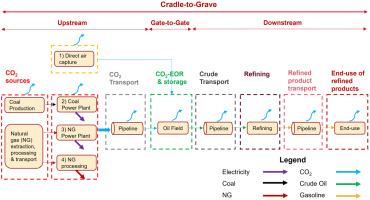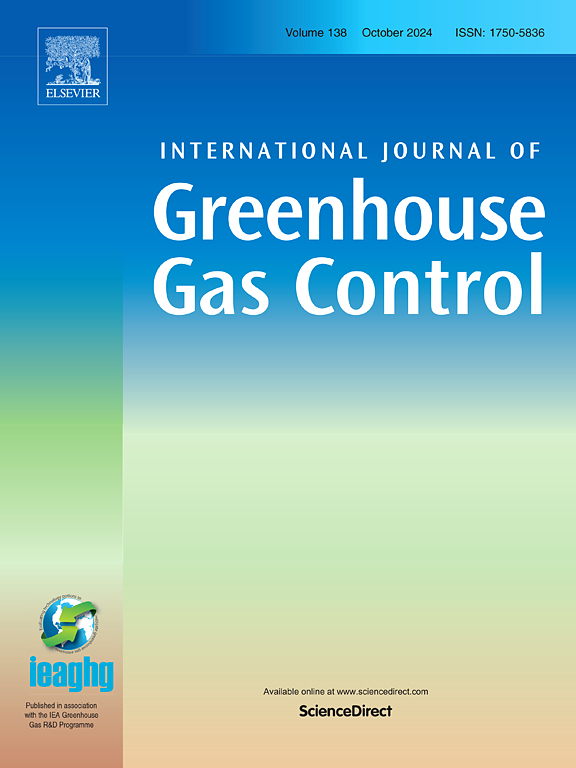迈向CO2-EOR的一致性评估:生命周期评估的荟萃分析
IF 5.2
3区 工程技术
Q2 ENERGY & FUELS
International Journal of Greenhouse Gas Control
Pub Date : 2025-06-23
DOI:10.1016/j.ijggc.2025.104430
引用次数: 0
摘要
在过去的二十年中,对二氧化碳提高采收率(EOR)生命周期碳足迹的广泛研究已经产生了广泛的结果,但不一致的方法阻碍了这些评估对政策制定的可靠性。为了解决这些方法上的不一致性,本研究对全球生命周期评估(LCA)研究进行了系统的荟萃分析,研究了利用自然和工业来源的CO2-EOR系统的温室气体排放因子。该研究开发并实施了一个标准化的评估工作流程,包括综合筛选、资格评估、纳入/排除标准、数据验证、聚类和关键背景参数(特别是电网排放因素)的协调。该分析采用经济分配和替代两种方法来评估整个供应链的生命周期排放因子。统一的门到门(GtG)排放系数范围为14 ~ 167 kg CO2e/桶,中位数为56 kg CO2e/桶。统计分析显示,电力消耗与排放因子的相关性强于净CO2利用,这强调了电力来源在LCA评价中的重要性。当扩展到从摇篮到坟墓的边界时,分配方法的选择成为LCA的主要驱动因素,温室气体排放因子中位数从使用经济分配的+538 kg CO2e/桶到使用替代方法的-250 kg CO2e/桶不等。此外,CO2源特征、驱替原油类型和EOR工艺设计对结果有显著影响。这一系统评估强调了标准化监测和全面报告排放和逸散排放的必要性,以减少LCA的不确定性。研究结果表明,方法选择、边界定义和基本假设如何对二氧化碳- eor排放因子评估产生重大影响,为增强未来lca的稳健性提供指导,并为可靠的政策和研究建议提供信息。本文章由计算机程序翻译,如有差异,请以英文原文为准。

Toward consistent evaluation of CO2-EOR: A meta-analysis of life cycle assessments
Over the last two decades, extensive research on the life cycle carbon footprints of CO2-enhanced oil recovery (EOR) has yielded a wide range of results, yet inconsistent methodologies have hindered the reliability of these evaluations for policy development. To address these methodological inconsistencies, this study conducted a systematic meta-analysis of global life cycle assessment (LCA) studies examining GHG emission factors from CO2-EOR systems utilizing both natural and industrial sources. The research developed and implemented a standardized evaluation workflow incorporating comprehensive screening, eligibility assessment, inclusion/exclusion criteria, data validation, clustering, and harmonization of critical background parameters, particularly electricity grid emission factors. The analysis employed both economic allocation and substitution approaches to evaluate life cycle emission factors across the complete supply chain. The harmonized gate-to-gate (GtG) emission factors resulted in a range from 14 to 167 kg CO2e/bbl, with a median of 56 kg CO2e/bbl. Statistical analysis revealed that electricity consumption exhibited a stronger correlation with emission factors than net CO2 utilization, emphasizing the importance of electricity sourcing in LCA evaluations. When expanding to cradle-to-grave boundaries, the choice of allocation methodology emerged as a dominant driver of LCA, with median GHG emission factors varying from +538 kg CO2e/bbl using economic allocation to -250 kg CO2e/bbl using substitution approaches. Additionally, the CO2 source characteristics, the type of displaced crude oil, and the EOR process design were found to significantly influence results. This systematic assessment underscores the imperative for standardized monitoring and comprehensive reporting of venting and fugitive emissions to reduce LCA uncertainties. The findings demonstrate how methodological choices, boundary definitions, and underlying assumptions critically impact CO2-EOR emission factor evaluations, providing guidance for enhancing the robustness of future LCAs and informing reliable policy and research recommendations.
求助全文
通过发布文献求助,成功后即可免费获取论文全文。
去求助
来源期刊
CiteScore
9.20
自引率
10.30%
发文量
199
审稿时长
4.8 months
期刊介绍:
The International Journal of Greenhouse Gas Control is a peer reviewed journal focusing on scientific and engineering developments in greenhouse gas control through capture and storage at large stationary emitters in the power sector and in other major resource, manufacturing and production industries. The Journal covers all greenhouse gas emissions within the power and industrial sectors, and comprises both technical and non-technical related literature in one volume. Original research, review and comments papers are included.

 求助内容:
求助内容: 应助结果提醒方式:
应助结果提醒方式:


